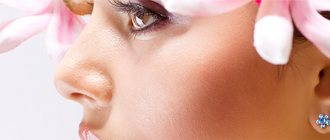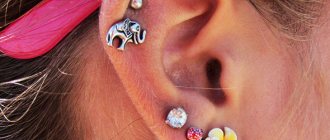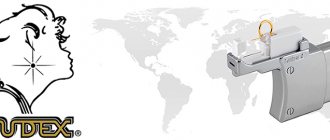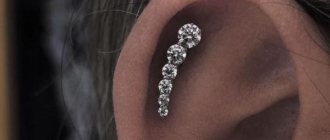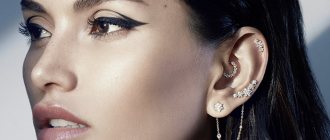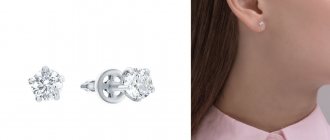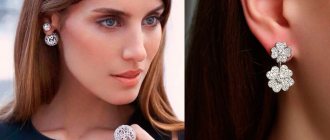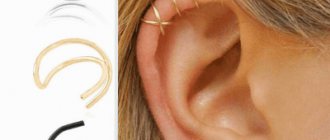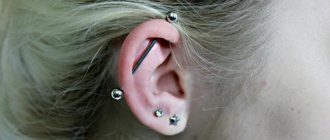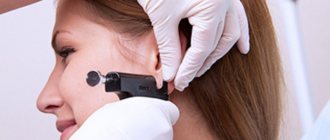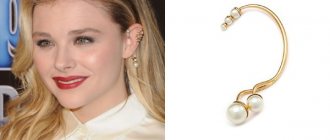Reads: 2,461
Reading time: 6 min.
no comments
Today, piercings will no longer surprise anyone, although fashionistas and fashionistas pierce rather unexpected parts of their bodies.
What about the most traditional type of piercing – earrings?
If you don’t risk piercing your eyebrow or lip, get an original and beautiful ear piercing - for girls this is a great opportunity to be trendy without being too shocking.
Types of ear piercing
Professional piercers distinguish 34 types of ear piercings. Options are classified by location.
Ear piercing with a gun
The most common types of ear piercings (with photo):
- Lobe piercing
. The softest part of the ear is pierced. Healing is similar to any other piercing of the fleshy areas of the body;
Lobe piercing - Helix
. The hole is made in the upper part of the helix of the auricle. During its execution, no pain is felt, because there are no nerve endings in the cartilage; Helix puncture - Anti-helix or Snug piercing
. It is done in the upper cavity of the auricle. Unlike a regular helix, here the cartilage is pierced in two places;
Snug piercing - An upper helix
is an ear piercing located at the top of the helix of the auricle, as close to the head as possible. Due to the complexity of the implementation, it is done very rarely; mainly carnations are used for decorations; - The most difficult type of ear piercing is Daith
. Its meaning is related to the acupuncture teachings of India. They say that this is not just a decoration of the body, but provides protection for the “vessel”. To make Daze, you need to prepare a special curved needle that can pierce the middle ear cartilage. The placement of the earring plays a decisive role in this type of piercing: if holes are visible, the Daith is considered to be of poor quality;
Earring for Daith - Tragus or tragus
. It got its name because of its location. It is believed that this type of piercing is very painful, although it, like many other types of punctures, is located in the cartilage;
Tragus - Piercing of the lower part of the ear or antitragus
. Also, the decoration can be located in the curved cartilaginous tissue of the helix;
Antitragus - Industrial
. Professional ear helix piercing with two piercings. Subsequently, they are connected to each other using a long earring - a barbell. For maximum convenience, the pierced points should be parallel to each other. Although, occasionally, it is allowed to raise the second part of the earring slightly above the point where the first hole is located; Industrial piercing - Rock
outwardly very similar to the puncture of the antitragus, but differs in lower requirements for the holes for installing the earring. The decoration is located on top of the tragus, in the auricle;
Piercing rock - Fallout
. A special feature of this piercing is the arrangement of the earrings. Most often, several parallel Helix punctures are made, after which rings of the same diameter are inserted into them.
Story
Ear piercing is one of the most ancient modifications that people have used to express themselves. This place is easy to puncture, it bleeds little and heals quickly, so the choice becomes obvious.
During one of the expeditions, a group of scientists found the body of a man who lived more than 5 thousand years ago. This event occurred in 1991, after studying the find it became known that he not only had ear piercings, but also stretched earlobes. Another proof is the death masks that were made for the rulers of Egypt, and earrings were found in both sexes.
In the 16th century, the fashion for such accessories returned to Europe; ear piercings began to be performed by sailors and people who were at the royal court. Then the trend moved to the West, where ear piercings were done for no apparent reason. Over time, this trend went out of fashion and became the lot of people from the lower classes. After the war, women began to pay attention to their appearance again, but it was only 30 years after this that ear piercing became a separate procedure that doctors began to perform. Until the 80s, all piercings were done independently, using ice to freeze the area.
Ear piercing with a gun
An earlobe piercing is most often performed with a pistol. It is important to note that the vast majority of professional piercers do not recognize guns in principle. Instead, they use needles or catheters.
Ear piercing in salon
How an earlobe piercing is done by a doctor in a salon:
- The selected area is carefully treated with alcohol-containing solutions. Based on the location of acupuncture points (points, the exact location of the future hole is selected);
- Needles are inserted into the gun (they must be in a sterile container). The selected earring is placed next to the needle;
- The planes of the gun are placed above the earlobe, the needle should be located exactly above the selected and marked puncture site. Afterwards, the doctor sharply presses the handles of the device and its planes close;
- The needle pierces the skin, and the decoration is immediately pushed into the hole. The pistol is unfastened and removed from the ear, and the earring is secured with clips.
Industrial ear cartilage piercing - how to do it correctly: description
Piercing is a very serious decision, and industrial ear cartilage piercing is also a painful, long-healing process. Therefore, you should take this issue very seriously and choose a proven, experienced master.
To do this, you should immediately discard the craftsmen who work in a handicraft way, since real professionals work in sterile areas of salons, respecting themselves and their clients. Also check out the master’s certificates and portfolio. After visiting the salon, make sure that the master clearly understands the goal and has sterile objects in his work. Ask for pain medication if needed.
Important: pistols are not a hope in such matters, since they cannot be completely sterilized, and when beaten, they may shift by a fraction of a millimeter, but later this will play a negative role. Choose a master who works only with needles.
Before the procedure you need to prepare:
- Do not drink alcohol, aspirin or other blood thinners;
- If you have any illnesses, inform the specialist and, if necessary, consult a doctor;
- Take your passport and cash with you (if you plan to pay by card, ask in advance, since most often salons do not accept non-cash payments).
Now about how the process of industrial ear piercing goes:
- The puncture site is disinfected;
- If necessary, the specialist numbs the area with an injection;
- The location of the holes is marked, a mirror is extended, and the client evaluates everything again;
- If you don’t like the points, the client asks to move them, the specialist moves them if it can be realistically implemented;
- Reconciliation occurs again;
- If everything is satisfactory, a puncture occurs with a needle;
- A rod is inserted into the hole and checked additionally with the second hole;
- A second puncture occurs;
- The bar is inserted into the second puncture and closed;
- If there are more punctures, they all go sequentially;
- The piercing is disinfected again, and you examine your ear in the mirror.
In this procedure, everything is discussed “on shore”, since after the puncture nothing can be changed. Therefore, a mirror is provided to check the work, but not to make adjustments.
Unusual industrial ear piercing
How to pierce with a needle
If medical services of this kind are not suitable, then ear piercing can be performed at home. To do this, you can purchase a special Studex gun, which is used in salons, or buy a catheter of a suitable size at the nearest pharmacy.
Catheters
As a standard, they come in 6, 8, 12, 13, 14, 16, 18, 20 mm. Naturally, the size of the hole must correspond to the diameter of the decoration.
Piercing punches
Specialized piercing stores also sell professional needles. They are made from an alloy of steel and titanium. Like catheters, they are classified by size (1; 1.1; 1.2, etc.).
Drawing of types of ear piercings
How to perform ear cartilage puncture at home:
- A place is marked on the ear. To do this, you can use a regular alcohol-based felt-tip pen;
- It is very important to thoroughly clean your hands and ears. For disinfection purposes, you can use Chlorhexidine or pure alcohol. If you don’t have either one or the other at hand, then use vodka or other strong alcohol (more than 40%);
Ear piercing at home - The hole is made on the outside of the cartilage so that its location can be seen. The auricle is stretched and manipulation is performed. Blood may appear at the site of the hole - don’t worry, everything is normal, in the cartilage, like in other parts of the body, there are small vessels and capillaries. You just touched one of them;
- While the needle is in the ear, you need to insert an earring in its place. We recommend using a nail - it is easiest to install in a fresh hole. The hole is washed with “Chlorhexidine”, “Miramistin” or alcohol, the needle begins to be carefully pulled out of it, and the earring, on the contrary, is inserted;
Miramistin - To make the stud fit inside the puncture easier, you can apply any regenerating ointment to its tip.
The technique may vary depending on the type chosen, but in general, the system is the same. At first, ichor will appear around the earring - it must be washed off with Chlorhexidine all the time. Do not use peroxide under any circumstances, otherwise you will delay the healing process for many months.
Chlorhexidine
How to wear it to look stylish?
Two holes in the ear (photos of the “grown-up Hermione” by Emma Watson gave rise to a real boom in creating images with an elegant cuff earring) - an extravagant but incredibly popular trend, previously considered a distinctive feature of informals and rock musicians.
Gradually taking over the catwalks of the world, the trend has undergone many changes over time, becoming a sign of extravagance and style, as well as a characteristic symbol of equality between the sexes, carefully promoted by Hollywood celebrities.
Stylists recommend performing a second piercing only on one ear, inserting a hoop earring or chain into the main hole located in the earlobe, and placing a small stud jewelry in the second hole.
Girls who love extravagant, but at the same time very cute looks, can wear 2 small rings of the same size on their ears, but the most stylish variation is considered to be massive rings, complemented by a small stud earring with a gemstone sparkling in the sun.
Interest is gradually growing in non-standard earrings, designed for 2 holes located in one ear, most often representing 2 studs with a chain or spiral running between them. The first decoration option looks good when creating a classic double piercing of the earlobes, and the second looks impressive when piercing the cartilage.
In order to create a harmonious and stylish ensemble with several earrings, long-haired girls are recommended to lift their hair up or put it in a ponytail when choosing jewelry, maximizing the area of the ears. This look does not require additional jewelry, but can go well with a wristwatch, a thin chain and several rings.
For those with short hairstyles, two earrings in one ear will give them a playful, youthful and daring look that looks great in an informal setting, but is not entirely appropriate in an office or business dress code.
The central part of a stylish look should be the largest earring located on the earlobe. It can be made in the darkest color, with a hanging part or with non-standard decorative elements.
The accent detail of the image is selected from:
- conco earring;
- cuffs;
- Jackets;
- chains or suspenders.
Any jewelry of a non-standard shape can act as an accent with this variation, but stylists recommend abandoning the classic earring with an English lock.
System 75 for ear piercing
If you don’t want to bother with catheters or needles, we recommend purchasing a special system for piercing from the company Stadex - System-75. It is often used in beauty salons for simple piercings of the nose, ear and lip. If you need equipment for more complex piercings, such as septum or tongue, then it is better to choose a professional set of tools.
In addition to the System 75, Caflon Clinic devices are actively used by home piercers.
Types of jewelry for punctures in cartilage
There are a huge number of varieties of jewelry for punctures in cartilage. Below are the symbols that are used to call earrings on ear cartilage.
- A barbell is a decoration that consists of a base, a straight stick, a disk, a ball or a wrap.
- Microlabret – distinguished by the thinnest rod.
- Banana is a curved rod with balls on both sides.
- Spiral - the name speaks for itself, since it is an earring in the form of a spring.
- Circular - looks like a crescent, and there can be balls along the edges, but not necessarily.
- Microbanana is a barbell shape with a curved shaft.
- Hard - it looks like a round ring with various additions.
- Labret - consists of a base, a ball, and a wrap.
For recently completed punctures, a barbell or labret is best suited. Also, the type of decoration depends on where the puncture is made.
When can you change an earring in your ear cartilage? Everything is extremely simple - as soon as the fresh puncture wound heals.
How long does it take for ears to heal after a piercing?
The rate of tissue healing varies greatly between adults and children. We will look at how much tissue regeneration occurs after piercing in young people after 17:
| Type | Time (weeks) |
| Earlobe | 2–4 |
| Helix | 8–10 |
| Anti-helix, upper helix | 6–8 |
| Daith | Up to 12 |
| Industrial | 8–10 |
| Tragus, tragus, antitragus | 6–12 |
At the same time, if you remove the earring, the ear will heal much faster. For example, an unsuccessful lobe piercing will be invisible 2 months after removing the jewelry, and a cartilage piercing will be invisible after 3 months.
Symptoms of complications after an incorrectly pierced ear
After puncturing the cartilage, you should monitor it very carefully. There are several signs that indicate that healing is not going according to plan:
- Throbbing pain is a serious sign of improper healing. If a lot of time has passed since you got the puncture, and your ear continues to hurt, then you should consult a specialist, or, if necessary, a doctor.
- Pus is a serious sign that things are not going according to plan. It should not exist, both at first and after weeks and months.
- Tumor. Minor swelling is possible only during the first time after the puncture. Later, this is a reason to consult a doctor.
- Formation of a keloid scar or scar.
If the healing process slows down, you should seek medical help.
How to treat ears after piercing
To prevent the ear from becoming inflamed, it is important to properly treat it after the piercing. First of all, you will need mild antiseptics. This can be any available remedy, but remember that alcohol can greatly dry out the skin and reduce the healing rate.
Ear treatment after piercing
Sequence of ear piercing treatment:
- As soon as the piercing is done, you need to rinse the hole with Chlorhexidine and apply a small amount of Bepanten or Rescuer to it;
- Before washing your hair, to avoid complications, in the first 3 weeks of healing, you will need to cover all punctures (single and multiple) with a thick layer of fatty regenerating ointment. Ichthyol or “Rescuer” is ideal - they are greasy and do not wash off with water;
- Reviews claim that if after ear piercing they itch very much, then the healing process has begun. Just under no circumstances should you scratch these areas with your fingers;
- To prevent inflammation, the piercing should be washed twice a day and rotated regularly. If this is not done, then during the healing process the earring will grow into the skin;
- In the future, redness or bumps may appear on the overgrown piercing. If they have formed, then particles of skin and dirt have collected in the hole - just rinse the hole with peroxide; Drawing peroxide for piercing treatment
- To prevent inflammation inside the ear during the healing process, it is recommended to drip otitis media drops into the ear;
- If, after removing the jewelry, the piercing is overgrown, a second puncture can only be done in a different place. A hole in the same area is fraught with complications.
Post-piercing care
You have to monitor the puncture site and periodically treat it for 2-3 months. During this time, a channel is formed into which the earring can then be inserted without any problems. The first few weeks there is swelling, and bleeding or lymph may also be discharged. The photo below shows what the piercing looks like immediately after the piercing. The speed of healing largely depends on the puncture site and immunity.
Salons advise not to expose the area to hypothermia, so in cold weather you should always wear a scarf, hat or hood to protect the area. You can quickly take a warm shower, but you should not sit in the bath, sauna or go to the bathhouse for the first 1.5 months. It is also better to exclude swimming pools and bodies of water with water of questionable quality. You are allowed to swim in the sea, this will even speed up healing, but the area will sting.
The first few weeks after the puncture, the site is treated daily with an antiseptic and some kind of healing solution, for example, Levomikol. Usually a person is given a small reminder, but just in case, we will duplicate the scheme for processing this place.
To speed up healing, it is recommended not to touch the area with your hands, not sleep on this side, and change bedding every 3 days. If you go to the salon and follow the master’s recommendations, you will not have any problems with the healing of the piercing.
If your ear hurts or festeres after a piercing
After ear piercing there can be different consequences. Immediately after the piercing, swelling will begin. There is no need to remove it - with normal healing it will go away the next day. If this does not happen, and the ear is completely swollen, then suppuration of the lobes or cartilage begins.
Ear piercing inflammation
Tips on what to do if your ear festers:
- The piercing site must be thoroughly treated with an antiseptic. Miramistin is ideal;
- To prevent lumps from forming at the ear piercing site in the future, you need to lightly knead the tissue every day. If numerous granulomas have already appeared, only professional treatment will help;
- It is strictly forbidden to sleep on the side of the punctures. This contributes to poor circulation;
- If a lump has formed there that hurts or itches, it’s a granuloma. It is a “skin bag” containing pus inside. The most important thing is to remove the purulent fluid. Ichthyol ointment, onion gruel, aloe leaves will help with this;
Ear inflammation after piercing - Any of the selected products is applied as a compress to the affected area for several hours. After 2–3 hours, remove the compress and replace it with a new one. After the second time, you need to rinse the hole with hydrogen peroxide; in most cases, this is enough for the pus to begin to come out;
- If the ball is too large, then it is optimal to squeeze out the pus manually. To do this, take a cotton pad and moisten it generously with any available antiseptic. Just below the puncture site, begin to apply light pressure on the lump. Pus will come out of the hole. As soon as this happens, press a little harder. To finally get rid of the granuloma, apply a compress with ichthyol ointment to the piercing site.
In addition, even despite proper care and careful handling of the puncture, the body may begin to reject the earring. During the process, the temperature may rise, the ear will become very sore, and pus may even be discharged. You can try installing an earring made of noble metal or a ring (this will make it easier to wash). If this does not help, you will have to remove the jewelry.
Contraindications for puncture
Before performing a puncture, it is very important to make sure that you have no contraindications to it. So, cartilage piercing is contraindicated in the following cases:
- Chronic skin diseases: this includes dermatitis, furunculosis and other rashes.
- Growing organism (childhood, period of active growth). Age is key. If you are under fifteen years old, it is better to avoid this procedure, as the puncture process can weaken the immune system, and healing will take a long time.
- Pregnancy and lactation period are the times when it is better not to carry out this procedure.
- Mental illnesses.
- Blood clotting disorder.
- Heart disease.
- Kidney failure.
- Peptic ulcers of the gastrointestinal tract.
- Oncological diseases.
- Bronchial asthma.
- Predisposition to allergies.
- Gynecological diseases - stress can lead to their exacerbation and complications.
- Various ear diseases.
- Recent traumatic brain injury.
- Viral and infectious diseases.
You may be interested in: Chrysoberyl stone: photo, properties, color and meaning, application
As you can see, there are many contraindications, so you must approach the puncture for wearing an earring in the ear cartilage with all responsibility. And the client’s ignorance of contraindications to puncture manipulation can become the root cause of serious consequences.
Only if there are no restrictions can you start choosing a specialist. A photo of an ear with a cartilage puncture and an earring in it is presented below.
Ear piercing earrings
For quick healing, it is important to choose an earring that is suitable for a specific puncture. Beautiful decorations are not always practical or convenient, so this needs to be thought through in advance.
Types of stud earrings for piercing
Types of earrings:
- Carnations. Classic jewelry. Suitable for piercing earlobes in children or for filling numerous holes in cartilage; Stud options
- Rings. Promotes rapid healing. Thanks to their shape, they greatly simplify care;
Unusual rings for piercing - Barbells. They consist of balls at the edges and a flat pin in the center. Just like rings, it is easy to care for. Suitable for industrial and anti-helix;
Options for barbells in the ear - Snails. An extremely rare ear decoration due to its unusual shape, but if it is made by Daze, then this is the best choice. They allow you to hide puncture marks and are attached very tightly - they definitely won’t get lost.
Industrial bar
Earring for multiple punctures.
Based on the material, they are divided into plastic, metal (steel, nickel, titanium) and noble (gold, platinum and silver). Plastic has various contraindications due to its high surface roughness. Some girls say that this material slows down healing.
Ear piercing jewelry
Nowadays ear piercing jewelry can be chosen to suit every taste and color. They are made from different materials - silver, gold or medical steel, but they are not suitable for piercings due to the presence of nickel in the alloy, which oxidizes when worn. Titanium jewelry is the highest quality and safest . It is the choice of material that determines how long an ear piercing will take to heal.
Stud earrings and studs have faded into the background; the most popular piercing jewelry has become labrets with wraps, microbananas, barbells, clickers or circulars , the size of which is selected individually for each person. Often, ear piercings on top are decorated with clusters, which are arranged in the shape of the ear, and piercings inside the ear are decorated with clickers with cubic zirconia or opals.
Photo examples of ready-made options
Helix piercing care
Means to treat the damaged area:
- Miramistin spray;
- Levomekol ointment;
- anti-pollution patches.
Laughter of care for the first month:
- 1-2 weeks. Rinse with spray, lubricate with ointment;
- 3-4 weeks. Rinse with spray.
For the first month, it is recommended to avoid visiting baths, saunas and hot tubs.
Double-sided earrings (front to back)
These earrings function as their name suggests. The front earring is attached to the back earring. The stone or decorative part of the back earring is always larger than its front “friend”, and thus the back fragment is visible to everyone.
We recently wrote about the most famous variety of such double earrings – the Mise an Dior ball studs.
Possible infections and consequences
Causes:
- Decoration is removed too early;
- Swimming in open water;
- The puncture site is not treated;
- The ear is pierced incorrectly.
Consequences:
- Crushing of cartilage with possible death;
- Formation of scars that do not heal holes, followed by necrosis;
- Allergic reactions to decoration material.
